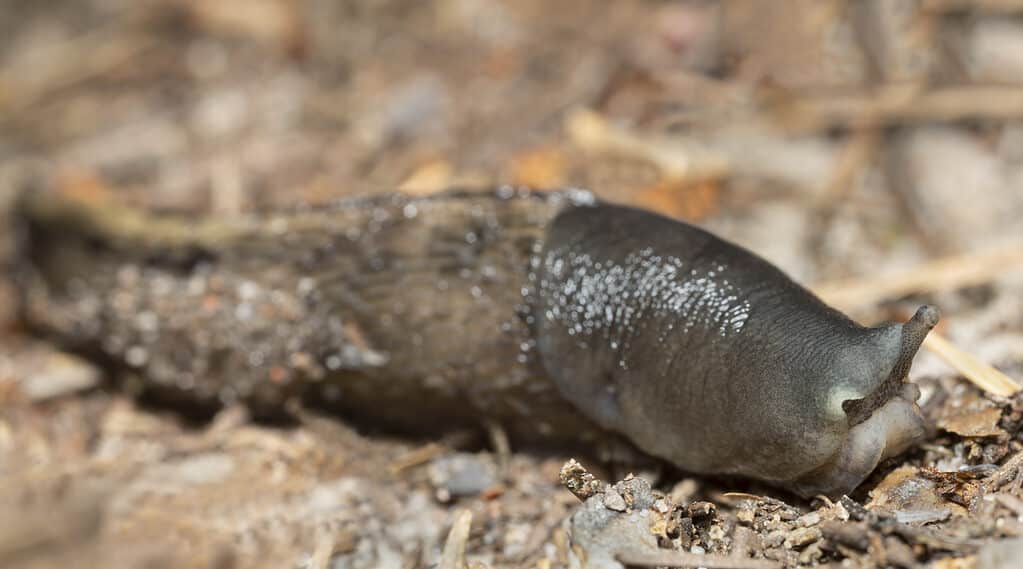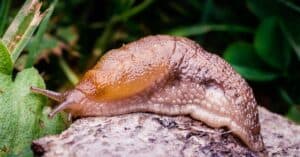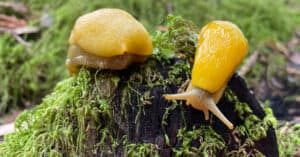Have you ever heard of the world’s largest slug? If not, you are in for a big surprise! The Limax cinereoniger is a species of slug that is actually bigger than a football! Not only is this slug huge, but it is also unique and fascinating in many ways. Buckle up because this enormous slug is about to blow your mind! Let’s discover the largest slug in the world!
Meet the Limax Cinereoniger!
Limax cinereoniger, also known as the ash-black slug, is a type of land slug that belongs to the Limacidae family. It is also known as the keelback slug. What sets the Limax cinereoniger apart is its impressive size – it’s the largest land slug species in the world!
They may not be the most glamorous creatures, but they are certainly interesting to learn about.
Size And Appearance

Limax cinereoniger is the largest land slug in the world and it belongs to the Limacidae family.
©iStock.com/Henrik_L
These slugs are known for their impressive size, as they can grow up to 8 inches when fully mature. However, it is normal for this slug to reach up to 12 inches in the UK. In contrast, the Arion ater is one of the most common slugs and grows up to 5½ inches at maturity.
They also have colors ranging from pale grey to light brown or jet-black. A tan-to-white stripe runs from the posterior edge of the mantle to the tip of the tail. This stripe is a key characteristic, as it is absent in a similar species, the Limax maximus.
In addition to their striking appearance, ash-black slugs are also notable for their keeled shape. They have a pale ridge, or keel, running along their back. Some ash-black slugs also have thick black and grey stripes along their bodies.
One way to distinguish the Limax cinereoniger from the Limax maximus is by looking at the sole of the foot. The underside of the adult ash-black slug’s foot is dark grey with a white stripe down the middle. In contrast, the Limax maximus has a uniformly white sole.
However, it can be easy to confuse juvenile Limax cinereoniger with adult Limax maximus due to their similarly colored sole.
Distribution
If you live in Europe or the Mediterranean region, you may have encountered these slimy creatures at some point. They are native to this part of the world and can be found in most European countries. Some of these include Bulgaria, the Czech Republic, Italy, the Netherlands, Slovakia, Great Britain, Ireland, Finland, and Ukraine. They can also be found as far east as the Urals. While they are widespread, it is rare to spot one as they are very spread out.
While this slug is common in many parts of its range, it is absent in the southernmost parts of Europe. It inhabits the Iberian Peninsula and the Balkans, but there are no records of it in Portugal or Greece. It is not found in northern Scandinavia, Iceland, or the farthest southern parts of the Mediterranean.
Your best chance of spotting these giant slugs is in the UK or Europe, with the exception of a few specific areas. It would be hard to miss such a massive creature.
Habitat
The Limax Cinereoniger slug can be found in diverse natural forests and shrublands, including coniferous forests. It crawls on the ground and in trees but avoids cultivated forests.
Slugs tends to hide in stumps, decaying tree trunks, and under loose bark. Their presence can be indicative of ancient woodlands, even though they have been heavily modified by traditional management practices.
In Romania, the slug is mostly found in the mountains, where it is quite common. Meanwhile, in Britain, it is mostly found on non-calcareous soils. In Switzerland, it can be found at altitudes of up to 2,000 meters, while in Romania and Bulgaria, it can be found even higher.
They come out at night looking for food on the woodland floor, stumps, or even in trees. During the day, they hide under large pieces of dead wood to avoid predators and the hot sun.
You can spot adult ash-black slugs all year round, as they can be found in their habitat throughout the year. They are most active on damp nights when the humidity is high. However, you may be able to spot them during the day if you know where to look.
If you’re interested in seeing these slimy creatures in action, consider taking a nighttime walk through ancient woodland. Keep an eye out for their ash-black color and distinctive white stripe running down the back of their mantle.
What Does the Limax Cinereoniger Eat?
These slugs emerge from their hiding places on damp nights to search for food, including fungi, lichens, and algae. In addition to these plant materials, the Limax cinereoniger is also known to consume mushrooms.
Ecology
Slugs are often considered pests due to their voracious appetites and ability to damage plants. However, it’s important to remember that they are a vital part of the ecosystem and serve important roles in their environments. The Limax cinereoniger should not be thought of as a pest.
Like all animals, slugs have a place in the natural world. They play a role in maintaining the balance of their ecosystem. Next time you see a slug, take a moment to appreciate these fascinating creatures and their place in the world.
Limax Cinereoniger’s Lifespan
The Limax cinereoniger slug has a lifespan of up to five years and reaches maturity after about two years.
Limax Cinereoniger Reproduction
The Limax cinereoniger slug has both male and female reproductive organs and is capable of self-fertilization (meaning it reproduces asexually). However, they typically mate with other slugs of their species and fertilize each other’s eggs in a unique mating ritual. When mating, the slugs will begin by excreting a unique slime substance. Then the two slugs will insert their male reproductive parts into the female reproductive parts. In this way, they fertilize each other’s eggs.
Individual slugs lay a total of 400 to 800 eggs in batches of 40 to 250 between July and October. They lay them under mosses rather than inside soil. The eggs hatch after 20 to 30 days, and the resulting juveniles are initially 0.3 inches in length.
The slugs get their dark coloration after about a year, although sometimes it can happen after two to three months. They reach maturity around two years old at a length of 6-7 inches.
Slugs survive the first reproduction period and lay eggs again the following year.
Conservation Status
It is relatively common to find the Limax cinereoniger slug in certain areas of England, specifically the eastern lowlands. However, in Great Britain as a whole, the slug is becoming less common. It is considered threatened due to modern forest management practices.
In contrast, the slug is considered rare in Spain and Ireland and is sensitive to habitat changes in Spain.
Despite this, the International Union for Conservation of Nature (IUCN) has classified the Limax cinereoniger as least concern. It is not currently at risk of extinction and can still be found relatively easily in its natural habitat.
How Can A Slug Be So Big?
It is not clear why the Limax cinereoniger slug grows so large. There could be various factors that contribute to its size, such as genetics, environmental conditions, and access to food.
The slug may have evolved to be larger to better survive in its habitat or to have a competitive advantage in finding food or mates.
However, without more information on this particular species, it is difficult to know the reasons for its size.
There is limited research available on the Limax cinereoniger slug, as it is not a widely studied species. More research and data on the slug’s biology, ecology, and evolution could provide insight into why it is so large.
However, the size of a species is not necessarily an indication of its overall success in its environment. It is possible for a species to thrive in its habitat, even if it is not the most physically impressive.
Fun Facts About Limax Cinereoniger
Here are a few fun facts about the Limax cinereoniger slug.
- Did you know that slugs can come in a variety of colors? While the Limax cinereoniger slug is typically dark in color, it can also be found in white, yellow, and red.
- These slugs are hermaphrodites, which means they have both male and female reproductive organs. However, it still generally takes two slugs to complete the mating process.
- According to research conducted in 1950, the Limax cinereoniger slug has the ability to react to smells.
- Out of the 44 known slug species in Britain, the Limax cinereoniger is the largest.
- While some gardeners consider slugs pests, ash-black slugs are unlikely to be found near precious plants like lupins or hostas.
- Limax cinereoniger slugs prefer humid or moist conditions.
Up Next
The photo featured at the top of this post is © iStock.com/mdurajczyk
Sources
- idtools.org, Available here: https://idtools.org/id/mollusc/factsheet.php?name=Limax%20cinereoniger
- naturespot.org, Available here: https://www.naturespot.org.uk/species/ash-black-slug
- molluscs.at, Available here: https://www.molluscs.at/gastropoda/terrestrial.html?/gastropoda/terrestrial/limax_cinereoniger.html
- animalbase.uni, Available here: http://www.animalbase.uni-goettingen.de/zooweb/servlet/AnimalBase/home/species?id=342
- buglife.org (1970) www.buglife.org.uk
FAQs (Frequently Asked Questions)
Is the Limax Cinereoniger larger than a football?
The Limax Cinereoniger is larger than a football. It is an enormous slug and the largest in the world, reaching over 12 inches in size!
Where is the Limax Cinereoniger found?
The Limax Cinereoniger or ash black slug can be found in most regions of eastern, and central Europe. It is also widespread in the UK.
What does the Ash Black Slug eat?
The ash black slug, or the Limax Cinereoniger, eats fungi, algae, lichens, and other plant material on the forest floor.
How long do Ash Black Slugs live?
Despite their massive size ash black slugs only live around 2-5 years.
Can you eat ash black slugs?
Ash black slugs are not poisonous and theoretically will not cause harm if consumed. However, it is not recommended to eat slugs as they can carry dangerous parasites and diseases.
Thank you for reading! Have some feedback for us? Contact the AZ Animals editorial team.






